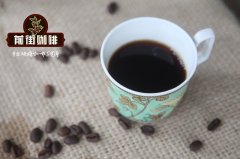Nicaragua Lemon Tree Manor Information material _ Lemon Tree Manor washing Catuai Coffee brewing suggestion

Professional coffee knowledge exchange more coffee bean information please follow the coffee workshop (Wechat official account cafe_style)
The Nicaragua plain has a high temperature and rainy climate, and belongs to a tropical maritime climate; in the western coastal lowlands, the precipitation is obviously less than that in the east, and there are dry and wet seasons, so it belongs to the savanna climate; the annual average temperature in the central highlands is 18 ℃, and the annual precipitation is 1500Mel 2500mm, with the rainy season from 5m to December.
Nicaragua is one of the major coffee producing countries, producing high quality coffee. The quality of coffee produced by several coffee-producing countries in Central America, Guatemala, Costa Rica and Nicaragua is similar, mainly due to weather conditions, soil fertility, planting height and other conditions.
Nepalese coffee cultivation and production has a unique environment, the spread of fertile volcanic ash soil, coupled with shade planting methods, to establish a good production quality, Nicaraguan coffee has a rich mellow and fragrant taste, moderate acidity and bitter taste are excellent, which is regarded as top grade in the eyes of international coffee experts.
Nicaraguan coffee of high quality is in the forefront of coffee beans in the world and enjoys a good reputation. Its particles are moderate in size, mild in taste and very aromatic and mellow.
Coffee is a pillar industry in Nicaragua, producing nearly 100,000 tons of coffee beans every year. Many people who have tasted Nicaraguan coffee usually think that it is no different from Salvadoran coffee or Honduran coffee. It is full-bodied, smooth and delicate, with a slightly bitter finish, like a faint taste in a wine.
The best coffee is produced in Matagalpa. The coffee produced here is highly respected by coffee lovers all over the world and gradually valued by the boutique community. Abundant precipitation, suitable temperature, high altitude, fertile soil and unique planting ecology are the prerequisites for creating high-quality Nicaraguan coffee.
Nicaragua is an economically backward agricultural country, is one of the poorest countries in Central America, the unemployment rate is very high, people live in poverty, and coffee is Nicaragua's pillar industry, producing nearly 100,000 tons of coffee beans every year. Due to the poor economic foundation, the coffee industry is still relatively backward, and coffee farmers are also in a relatively poor state. Although Nicaragua is a country with a large territory in Central America, it is not a big producer in the coffee world, and its output and reputation are much weaker than that of its neighbor Costa Rica. But the high-quality Nicaraguan coffee is in the forefront of coffee beans in the world and enjoys a good reputation. Traditional Nicaraguan coffee farmers are used to using water washing method for subsequent processing of coffee fruits. Coffee farmers are more accustomed to using water washing to ensure that the flavor of raw coffee beans is more stable and clean. it was not until about 2009 that the traditional attitudes of coffee farmers changed and began to try processing methods such as full sun and honey in more areas.
The Lemon Tree (El Limoncillo) Manor is located in the plateau of Matagalpa between 950 and 1300 meters above sea level. most of the coffee trees planted are surrounded by towering coniferous forests to provide shade for the growth of coffee trees. This allows coffee trees to be exposed to sunlight while protecting them from being burned by the scorching sun.
The current owner of the manor is Irwin. Erwin Mierisch, El Limoncillo Manor, in order to ensure the quality of coffee, the manual picking method is used to pick the fully ripe fruits one by one, which usually takes three times to complete. Although the manual picking method has high labor cost and low picking efficiency, it can greatly protect the plant from being hurt in the picking process, and the mature fruit will have better sweetness at the same time.
When it comes to El Limoncillo Manor, you have to mention a bean, Java Nica, which won the second place in the Nicaragua Excellence Cup COE National Competition in 2008. This bean has a beautiful appearance, delicate and rich flavor after washing, with aromas of fruit, vanilla and cream, and has gained more attention since then.
Lemon Tree Manor also processes coffee in a honey-treated way. After the coffee fruit is actually picked, the coffee with its exocarp removed is put on the African shed to dry. Compared with the traditional way of placing coffee directly on the ground to dry coffee, using African shed to dry coffee can reduce more pollution in the drying process, avoid producing more miscellaneous smell, and finally improve the quality of coffee. Honey-treated coffee beans have more attractive tropical fruit flavors.
The coffee beans with exquisite flavor presented in front of us, whether from the links of picking, planting, processing, or later packaging and transportation, are all devoted to the good intentions of the producers, in the process of taking the coffee system as something in the cup, we should also treat it attentively.
Legends of Java Nica varieties reappear
The Java-Long Berry species was once in danger, but eventually it was successfully restored in Nicaragua. She originated from the Java long species (Java) and came from the Indonesian island of Java, which can still be found in Java. The yield is low, and the local farm has gradually changed to other varieties because of poor disease resistance. Java species are similar to iron pickups in shape, and most of them are shortberry long species. The appearance of the variety is rare, but the flavor is very clean and delicate. In 2008, Niaga Java won the runner-up of the Nicaraguan National Excellence Cup. Niaga Java met the needs of many parties: scarcity, good flavor and full story!
One day in 2001, Ervin and his father drove to visit the landlord of the Commission for discipline Inspection, asked for advice on farming and treatment, and returned through the United Coffee Organization (Unicafa. When someone tried to stop a car at the coffee producers' organization in Nepal, Irwin said he wanted to go straight away, and one of the fathers stopped to see if he needed any help. It turned out that this man was working at the experimental station, which was forced to close due to a shortage of funds, and the experimental station had no cash to pay severance pay. He was only given a bag of seeds and a few broken shovels, so he had no choice but to stop and asked, "can you help me?" buy the seeds and tools that the lab gave me. Irwin's father agreed generously without hesitation.
Irwin said he was not impressed by his father's kindness, and that the bag of seeds needed to be marked with the word Java, which did not arouse much curiosity, because java was strange to most Nicaraguan coffee farmers, and Irwin did not feel the need to pay attention to unknown varieties.
After returning to his manor, Irwin's father carefully examined the seeds and sowed the seedlings. After the seedlings grew out, one day, the father and son took the young plants to consult the scholars at the experimental station in the 1980s. After she looked carefully, she confirmed that what Irwin and his son had inadvertently obtained was indeed Java. She said excitedly: Java is a great variety and it is worth planting! It should be noted that the harvest is not high, disease resistance is not added, need to be taken good care of! This is the first time that Java has been successfully sown and verified in Nicaragua.
In 2007, Irvina Java species participated in the Excellence Cup competition the next year, and won the runner-up in the Nicaragua Excellence Cup National Competition for the first time, and the bid even surpassed the champion of that year. Niaga Java became famous, setting off a huge topic in the coffee industry.
[Nicaraguan Coffee Manor-Lemon Tree Manor]
(EI LIMONCILLO ESTATE)
Country: Nicaragua (Nicaragua)
Manor location: Matagalpa (Matagalpa)
Town: Yuanliya, located in North Yashika. Dumara
(Yassica Norte Tumala de Dalia)
Date of establishment of the manor: 1932
Landowner: Maria. Miresh (Maria Ligia Mierisch)
Altitude: 950Murray 1300m
Main varieties: 10% Malagsippi Maragogipe, 30% Pacamara Pacamara, 25% bourbon Bourbon, 20% Kaduai Catuai, 15% Nika Java Java Nica
Variety name: Nika Java species (Java Nica)
Harvest time: December to March
Palate: greasy, rich tropical fruit, cinnamon sugar, vanilla plant, licorice sugar, good sweetness, changeable spices and tropical fruit sweet, black tea sweet, tropical flavor charming at low temperature.
From the picture above, we can see that even if the SOE is made of washed coffee beans, this bean is much more oily than other beans. We used 20g coffee beans, grinded with EK43 grinder 1.3degree of grinding, 20gVST powder bowl to extract, 22-24 seconds, extract 50g coffee liquid (powder / water ratio is 1 / 2 / 2. 5). Also in the case of making SOE with a large ratio of powder to water, the thickness and consistency of this washed yellow Pacamara SOE is still very good. Under the honey sweetness, the supple and bright acidity and outstanding nut and chocolate tonality complement the overall flavor and taste of this bean. Using this SOE to make milk coffee, the sweetness is also very obvious, and even has the obvious feeling of vanilla cream ice cream.
END
Important Notice :
前街咖啡 FrontStreet Coffee has moved to new addredd:
FrontStreet Coffee Address: 315,Donghua East Road,GuangZhou
Tel:020 38364473
- Prev

Indonesia Flower Island Bali Honey Coffee Flavor introduction _ Indonesia single Manor Coffee beans delicious
Professional coffee knowledge exchange more coffee bean information please follow Coffee Workshop (Wechat official account cafe_style) Flower Island Yellow Kadu Aimi treatment single Manor Micro batch Flores Yellow Caturra Honey Process country: Indonesia production area: Bali planting altitude: 1400-1500 varieties: Huang Kaduai treatment: honey treatment production season: 2016 hand 2
- Next

Introduction of special varieties of sun-dried coffee beans in Nicaraguan Holiday Manor _ how to drink Palenema coffee beans
Professional coffee knowledge exchange more coffee bean information please follow the coffee workshop (Wechat official account cafe_style) Nicaragua 2018 COE#15 bidding batch Nicaraguan Coffee Holiday Manor Palenema Sun Nicaragua Jinotega El Recreo Parainema Natural-flavor-cherry, passion fruit, cranberry Cherry, Passion Fruit, C
Related
- Detailed explanation of Jadeite planting Land in Panamanian Jadeite Manor introduction to the grading system of Jadeite competitive bidding, Red bid, Green bid and Rose Summer
- Story of Coffee planting in Brenka region of Costa Rica Stonehenge Manor anaerobic heavy honey treatment of flavor mouth
- What's on the barrel of Blue Mountain Coffee beans?
- Can American coffee also pull flowers? How to use hot American style to pull out a good-looking pattern?
- Can you make a cold extract with coffee beans? What is the right proportion for cold-extracted coffee formula?
- Indonesian PWN Gold Mandrine Coffee Origin Features Flavor How to Chong? Mandolin coffee is American.
- A brief introduction to the flavor characteristics of Brazilian yellow bourbon coffee beans
- What is the effect of different water quality on the flavor of cold-extracted coffee? What kind of water is best for brewing coffee?
- Why do you think of Rose Summer whenever you mention Panamanian coffee?
- Introduction to the characteristics of authentic blue mountain coffee bean producing areas? What is the CIB Coffee Authority in Jamaica?

